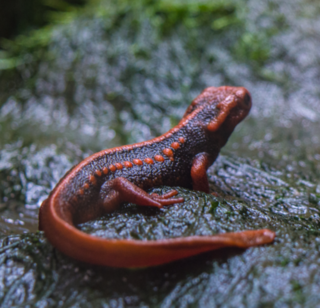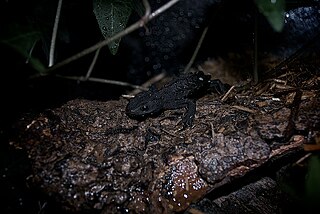
Salamandridae is a family of salamanders consisting of true salamanders and newts. Salamandrids are distinguished from other salamanders by the lack of rib or costal grooves along the sides of their bodies and by their rough skin. Their skin is very granular because of the number of poison glands. They also lack nasolabial grooves. Most species of Salamandridae have moveable eyelids but lack lacrimal glands.

Limnonectes is a genus of fork-tongued frogs of 91 known species, but new ones are still being described occasionally. They are collectively known as fanged frogs because they tend to have unusually large teeth, which are small or absent in other frogs.

Tylototriton shanjing, the emperor newt, Mandarin newt or Mandarin salamander, is a highly toxic newt native to Yunnan and parts of South China. It is sometimes seen in private collections, and is sometimes available for sale at certain reptile and amphibian-specializing pet stores and occasionally through captive breeders.

Tylototriton is a genus of newts known as crocodile newts or knobby newts. About 38 known species are in this genus. Many species have been described just recently. They range from northeastern India and Nepal through Burma to northern Thailand, Laos, Vietnam, and southern China.

The Pyrenean brook salamander or Pyrenean newt, , is a largely aquatic species of salamander in the family Salamandridae. It is found in the Pyrenees of Andorra, France, and Spain. The IUCN lists it as least concern.
Neurergus crocatus, the yellow-spotted newt, Azerbaijan newt, Azerbaijan mountain newt, mountain newt, or Lake Urmia newt, is a species of salamander in the family Salamandridae. It occurs in the mountains west of Lake Urmia, in northwestern Iran, northeastern Iraq, and southeastern Turkey.

Paramesotriton, also known as warty newts or Asian warty newts, is a genus of salamanders in the family Salamandridae. The genus is found in southwestern and southern China and in northern Vietnam. Most of the species are endemic to China, and the majority of them have been described recently, since 2008. The genus includes both pond and stream dwellers.

The red-tailed knobby newt or Kweichow (crocodile) newt is a species of salamander in the family Salamandridae. It is found in western Guizhou and north-eastern Yunnan, China. It is most closely related to emperor newt and Himalayan newt.

The Wenxian knobby newt or Wenxian knobby salamander is a species of salamander in the family Salamandridae. It is endemic to central China. Its type locality is Wen County in Gansu, or in Chinese: 文县; pinyin: Wénxiàn, hence the name.
Tylototriton vietnamensis, the Vietnamese crocodile newt or Vietnamese knobby newt, is a species of newt in the family Salamandridae. It is known from four localities in northern Vietnam where it occurs in and near ponds within dense bamboo vegetation. It is quite likely that it also will be found in adjacent areas of China and possibly Laos. It is possible that specimens earlier identified as T. asperrimus are in fact T. vietnamensis. However, based on molecular genetic data, its closest relative is T. hainanensis.

Tylototriton ziegleri, also known as Ziegler's crocodile newt or Ziegler's knobby newt, is a species of newt in the family Salamandridae. It is currently known from Hà Giang and Cao Bằng provinces in northern Vietnam, although its actual range probably wider; there is a photograph to suggest it also occurs in Lào Cai Province in Vietnam, and its range likely extends to Yunnan in southern China. Based on molecular genetic data, Tylototriton ziegleri belongs to the "Tylototriton asperrimus group" of newts. The specific name ziegleri honours Thomas Ziegler, a German herpetologist.
Crocodile newt may refer to:
Tylototriton panhai is a newt found in Thailand and Laos. It was recently distinguished from Tylototriton shanjing by Nishikawa et al., 2013.
Tylototriton uyenoi, the Chiang Mai crocodile newt, is a newt endemic to Chiang Mai Province, Thailand. It was distinguished from Tylototriton shanjing, the emperor newt, in 2013. The species was named in honor of herpetologist Shun-ichi Ueno. T. uyenoi is one of the few salamander species endemic to Thailand.

Tylototriton shanorum is a newt endemic to Shan State, Myanmar, where it was recorded in Taunggyi.

Tylototriton himalayanus is a species of salamander in the family Salamandridae. It is known from the Ilam District in eastern Nepal, Darjeeling in northwestern India, and western Bhutan. It is one of the only two species of salamanders found in India.

The angular-headed newt, also known as angular-headed crocodile newt, is a species of salamander in the family Salamandridae from Thailand, Laos, and Vietnam. Its unique orange markings help to distinguish it from other species, and also gave it the nickname "Star-Trek newt" or "Klingon newt", as it resembles the ridges on the head of the fictional Klingon species from the television show Star Trek.
Pachytriton inexpectatus is a species of salamander in the family Salamandridae. It is endemic to southern China and found in the Guizhou, Hunan, Guangdong, and Guangxi provinces. Its type locality is Mount Dayao of Jinxiu Yao Autonomous County, Guangxi. Prior to naming of this species in 2011, it was confused with Pachytriton labiatus. It is one of the several species that can appear in the pet trade as paddletail newt. The specific name inexpectatus is Latin meaning "unexpected" and refers to finding a species that is common in pet trade but lacked formal scientific description. Common name Yaoshan stout newt has been coined specifically for this species.
Tylototriton ngoclinhensis, the Ngoc Linh crocodile newt, is a species of crocodile newt native to the Central Highlands region of Vietnam. First discovered in 2018, it was described as a new species in 2023. Due to its small range, the newt is considered to be threatened and it has been proposed for it to be classified as endangered on the IUCN Red List.














